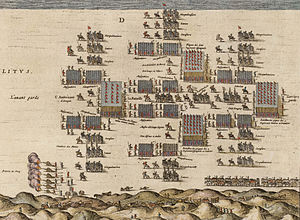
Back Exèrcit de Flandes Catalan Ejército de Flandes Spanish Armée des Flandres French Armata delle Fiandre Italian Leger van Vlaanderen Dutch Exército de Flandres Portuguese Фландрская армия Russian Flanders Ordusu Turkish
| Army of Flanders | |
|---|---|
 The Army of Flanders' deployment for the Battle of Nieuwpoort (1600). | |
| Active | 1567–1706 (dissolution) |
| Disbanded | 1706 |
| Country | |
| Allegiance | King of Spain as hereditary prince of the Low Countries |
| Branch | Spanish Army |
| Type | Tercio |
| Role | Security, control, and defense of the Spanish Netherlands |
| Size | 10,000[1] (1567) 86,235[2] (1574) 49,765[2] (1607) 77,000[3] (1639) |
| Garrison/HQ | Brussels |
| Commanders | |
| Notable commanders | Duke of Alba Julián Romero Sancho Dávila Duke of Parma Ambrosio Spínola Cardinal-Infante Ferdinand Marqués de Assentar Sebastian Fernandez de Medrano |

The Army of Flanders (Spanish: Ejército de Flandes; Dutch: Leger van Vlaanderen) was a field army of the Spanish Army based in the Spanish Netherlands between the 16th and 18th centuries. It was one of the longest-serving field armies of the early modern era, being founded in 1567 and disbanded in 1706. Taking part in numerous battles of the Eighty Years' War and Thirty Years' War, it employed or pioneered many developing military concepts, including permanent units (tercios), barracks and military hospitals long before they were adopted in most of Europe. As a result, the Army of Flanders has been considered the world's de facto first modern professional standing army.[4] Sustained at huge cost and at significant distances from Spain via the Spanish Road, the Army of Flanders also became infamous for successive mutinies and its ill-disciplined activity on and off the battlefield, including the sack of Antwerp in 1576.
- ^ Parker, El ejército de Flandes y el Camino Español, 1567–1659, p. 323
- ^ a b Parker, El ejército de Flandes y el Camino Español, 1567–1659, p. 315
- ^ Barratt (2016), p. 12.
- ^ Hale (1985), p. 67.